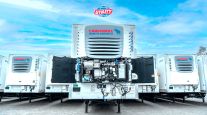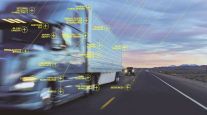Trailers of the Future Will Be Smarter, Lighter, More Aerodynamic
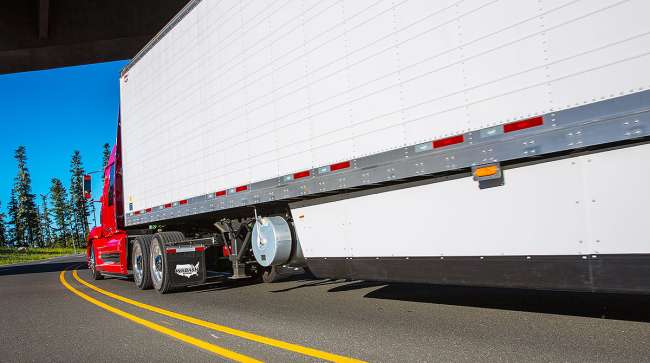
Dry van and refrigerated trailers will evolve over the next 10 years to become more connected, lighter, more durable and more aerodynamic than today’s equipment, executives at major trailer manufacturers said.
These trailers of the future also will detect potential maintenance issues and transmit other important information about the status of the trailer by employing advanced data collection capabilities.
“The trailer is going to become a rolling database,” said Robert Lane, vice president of product engineering at Wabash National Corp. “There will be more connectivity, more electronics and more data gathering on the trailer. All of this data will help fleets improve operations and be more efficient.”
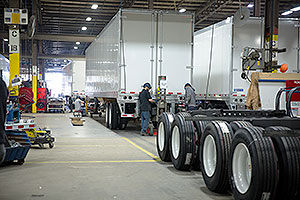
Workers assemble dry van trailers at Stoughton Trailers' manufacturing plant. (Stoughton Trailers)
More effective preventive maintenance is a key benefit of collecting more data from the trailer, said Jong Seog Lee, vice president of research and development at Hyundai Translead. “Smart trailers will play a vital role in helping fleets detect and monitor maintenance issues before they become serious problems,” he said.
Larry Hall, executive vice president for Premier Trailer Leasing, looks forward to having access to more maintenance data from smart trailers.
“We want to be able to notify a customer who is leasing one of our trailers about potential problems,” he said. “At some point in the future, we’re going to be able to take all that data and make it predictive.”
Sensors on trailers will monitor tire pressure, wheel bearing temperature, brake conditions, lighting and more. Many of these capabilities already are available today, but connectivity and compatibility issues have not been fully solved, some industry experts said.
Joey Young, manager of distribution fleet maintenance operations at Publix Super Markets, welcomes advances toward smarter trailers. His concern is the “fractured” nature of the technology currently.
“Everyone is competing for their own device,” he said.
“I hope that in the future there will be more collaboration between different manufacturers so that you can move to a different system and have it still work with the installed hardware. We need systems to be able to talk to each other,” he said, noting that currently there is no standardization, which is needed.
“Right now there are many different sensors that pull in all sorts of data but there’s not a smart component that can receive the data, run it through an algorithm and help improve trailer performance,” said Gary Fenton, chief design officer at Stoughton Trailers.
Fenton expects the problem will be solved by adding a hub in the trailer, similar to the engine control module in the tractor.
“Trailer OEMs have a role to play with creating a smart component that works with multiple systems,” he said.
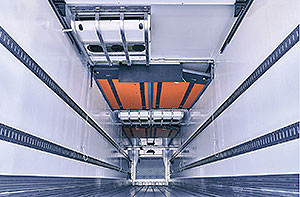
The interior of a Hyundai Translead refrigerated van. A company executive cited "smart" trailers as part of the future of fleet operations. (Hyundai Translead)
Hyundai Translead’s Lee also addressed the lack of compatibility among trailer devices.
“If a customer wants to switch telematics companies, all of the sensors and other hardware have to be changed,” he said.
In response, Hyundai Translead is creating sensors that can work with multiple telematics companies, he said.
Data collection also will provide fleets with other important information, such as payload weight, the amount of cargo remaining for multiple-drop trips and fuel reserves in the tank, said Craig Bennett, senior vice president of sales and marketing for Utility Trailer Manufacturing Co.
“Cameras and sensors inside the trailers will allow owners to monitor the cargo for temperature management, load shift, theft and cargo damage,” he said.
Justin Bell, vice president of engineering at Strick Trailers, stressed that the challenge is in “bringing it all together.”
The clear winners in the future will be the companies that can capture all of the right data and present it to the fleets in a user-friendly platform where it can be promptly processed and utilized, Bell said.
Another factor that will push trailers to become smarter is the move toward self-driving tractors.
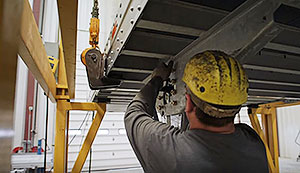
A Strick trailer in the manufacturing process. (Strick Trailers)
“The future trailers will have to be ‘smart’ to provide necessary data to autonomous power units,” said Chris Lee, vice president of engineering at Great Dane Trailers. “The data communication between tractor and trailer will have to be fast and fail-proof to achieve Level 4-to-5 autonomy and safety.”
Other characteristics of trailers in the coming years will be lighter weight and have greater durability through an increased use of composite materials, such as fiber-reinforced polymer resin, metal-plastic combinations and low-density bi-metals, said Great Dane’s Lee, who also is chairman of the Technology & Maintenance Council’s Future Trailer Productivity Task Force.
“The use of more composite material has started to gain popularity to fight against corrosion,” he said. “Composite coatings, thermal plastic coatings and noncorrosive metals are being studied more these days as well.”
One of the challenges with new materials, however, is their cost.
“Many of the materials used to create advanced composites are cost-prohibitive today, but the prices will come down,” said Lane of Wabash National. “The expanded scale of usage will drive prices down.”
Using composite materials will allow trailers to be constructed using fewer pieces, he said.
“The design will change so that the number of components in the overall structure will continue to go down,” Lane said.
Todd Cotier, director of maintenance for Hartt Transportation Systems of Bangor, Maine, expressed optimism about the potential improvements that are coming to future trailers, but pointed to cost as a potential stumbling block.
“Everyone wants weight savings, longevity and corrosion resistance,” he said. “We look forward to seeing how trailers improve in these ways, but we’ll need to see how the improvements will pay for themselves.”
In some cases, bonding will replace mechanical connection in the future as a method of trailer assembly, Stoughton’s Fenton said. “The increased use of bonding will allow trailer manufacturers to assemble trailers more quickly and with less manual labor.”
At the same time, the trailer manufacturing sector is facing a labor shortage, Lane said. “We either have to take steps to further automate the manufacturing process or find another way to reduce the required labor, because we just don’t have enough workers.”
For the use of new materials to take hold, fleets will need to be convinced there is a clear return on the investment, Hyundai Translead’s Lee said. Fleet owners will assess the total value and cost effectiveness of new technologies and materials.
“If the pricing does not add value or reduce the total cost of ownership, customers will hesitate and likely not commit to purchasing,” he said.
The current national crisis over a lack of sufficient funding for infrastructure improvements, meanwhile, may be relevant to the industry’s acceptance of new materials.
“Deteriorating roads in addition to the increased duty cycle will require trailers to withstand more stress and strain, so new materials like composites must be thoroughly tested for life-cycle durability compliance,” Utility Trailer’s Bennett said.
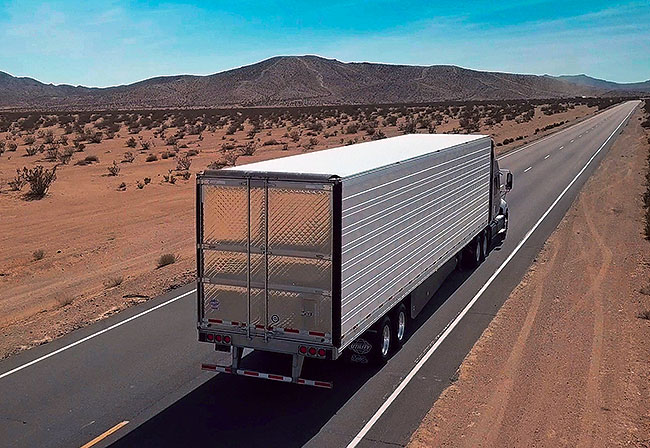
New materials such as composites will need to be able to withstand the strain of deteriorating roads and increased duty cycles, a Utility Trailer executive says. (Utililty Trailer Manufacturing Co.)
Composite materials can help create a much wider range of trailer shapes, and this encourages people to consider radical changes in design.
“Right now trailers are still mostly boxes on wheels, but that needs to change,” said Daryl Bear, lead engineer and chief operating officer at Mesilla Valley Transportation Solutions, which provides fuel economy testing for suppliers and fleets.
Bear worked on Indy racing cars before coming to trucking and brings that perspective to his vision of the trailer of the future.
Reducing the steel frame underneath or completely removing it would allow trailers to be much lighter, stronger and more aerodynamic, Bear said. “Think about an Indy racing car. It doesn’t have a frame. The outside of the vehicle is both the chassis and the body, and it’s all composite materials. We could do the same with trailers today.”
MVT Solutions is a division of Las Cruces, N.M.-based Mesilla Valley Transportation.
The aerodynamic advantages of moving away from the box-shaped trailer are perhaps inevitable. “Regulators and operators will demand trailers to be more streamlined with the tractor aerodynamically in body configuration, and at the same time, increased in freight capacity,” Great Dane’s Lee said. “An example is the ‘teardrop’ shape trailer body configuration with lowered deck.”
Trailers also will need to evolve to keep up with automation in warehouses.
“We’ve had several requests from various customers to integrate trailer design with automated dock equipment,” said Strick’s Bell.
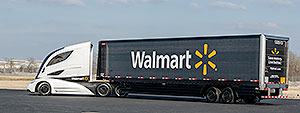
Great Dane produces a streamlined concept trailer for the Walmart Advanced Vehicle Experience prototype introduced in 2014. (Great Dane Trailers)
Automated loading and unloading may require trailers to have sensors that identify cargo within electronic grid marks, Stoughton’s Fenton said. “This would enable automated drones — flight or wheeled — to take individual packages from a trailer and handle the final delivery.”
Another possibility is trailers with an open-top design to allow loading of goods by overhead robotic crane, said Great Dane’s Lee. “As warehouse operations become more autonomous, trailers will have to be custom-designed to that particular automation.”
Government regulations likely will drive some of the changes in trailer design, but it’s currently unclear how the federal government’s Phase 2 greenhouse-gas emissions rule will impact trailer manufacturers.
That rule would have regulated trailer efficiency for the first time, but a federal appeals court halted implementation of those trailer standards in response to a legal challenge by the Truck Trailer Manufacturers Association.
The Environmental Protection Agency, which authored the Phase 2 rule in cooperation with the National Highway Traffic Safety Administration, has been reviewing the trailer regulation but has not provided details on the time frame for that process.
The industry, meanwhile, continues to wait for more clarity.
“In response to our lawsuit in 2017, a federal court issued a stay on the trailer portion of the GHG Phase 2 rule,” TTMA President Jeff Sims said. “Every 90 days, the EPA issues a statement saying that they are working on it and will provide another update in 90 days, so we remain in limbo.”


